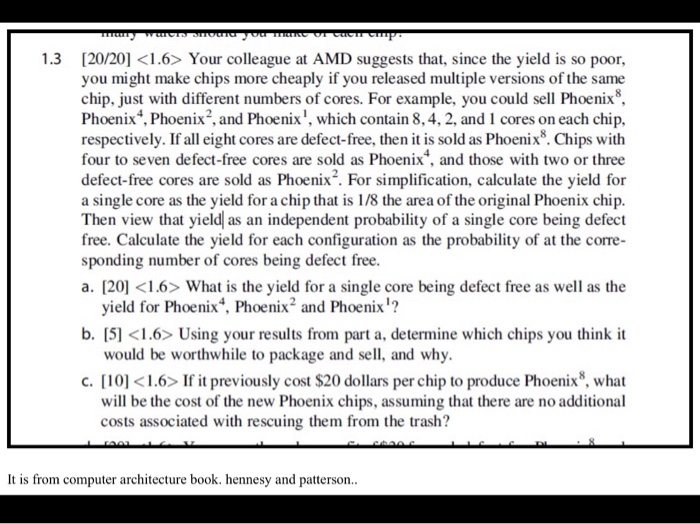Computer Architecture question
1.3 [20/20 Your colleague at AMD suggests that, since the yield is so poor, you might make chips more cheaply if you released multiple versions of the same chip, just with different numbers of cores. For example, you could sell Phoenix8. Phoenix4, Phoenix2, and Phoenix1, which contain 8,4, 2, and 1 cores on each chip, respectively. If all eight cores are defect-free, then it is sold as Phoenix8. Chips with four to seven defect-free cores are sold as Phoenix", and those with two or three defect-free cores are sold as Phoenix2. For simplification, calculate the yield for a single core as the yield for a chip that is 1/8 the area of the original Phoenix chip. Then view that yield as an independent probability of a single core being defect free. Calculate the yield for each configuration as the probability of at the corre- sponding number of cores being defect free. a. 120] What is the yield for a single core being defect free as well as the yield for Phoenix, Phoenix2 and Phoenix'? b. 151 Using your results from part a, determine which chips you think it would be worthwhile to package and sell, and why. c. [101 If it previously cost $20 dollars per chip to produce Phoenix, what will be the cost of the new Phoenix chips, assuming that there are no additional costs associated with rescuing them from the trash? It is from computer architecture book. hennesy and patterson.. 1.3 [20/20 Your colleague at AMD suggests that, since the yield is so poor, you might make chips more cheaply if you released multiple versions of the same chip, just with different numbers of cores. For example, you could sell Phoenix8. Phoenix4, Phoenix2, and Phoenix1, which contain 8,4, 2, and 1 cores on each chip, respectively. If all eight cores are defect-free, then it is sold as Phoenix8. Chips with four to seven defect-free cores are sold as Phoenix", and those with two or three defect-free cores are sold as Phoenix2. For simplification, calculate the yield for a single core as the yield for a chip that is 1/8 the area of the original Phoenix chip. Then view that yield as an independent probability of a single core being defect free. Calculate the yield for each configuration as the probability of at the corre- sponding number of cores being defect free. a. 120] What is the yield for a single core being defect free as well as the yield for Phoenix, Phoenix2 and Phoenix'? b. 151 Using your results from part a, determine which chips you think it would be worthwhile to package and sell, and why. c. [101 If it previously cost $20 dollars per chip to produce Phoenix, what will be the cost of the new Phoenix chips, assuming that there are no additional costs associated with rescuing them from the trash? It is from computer architecture book. hennesy and patterson







